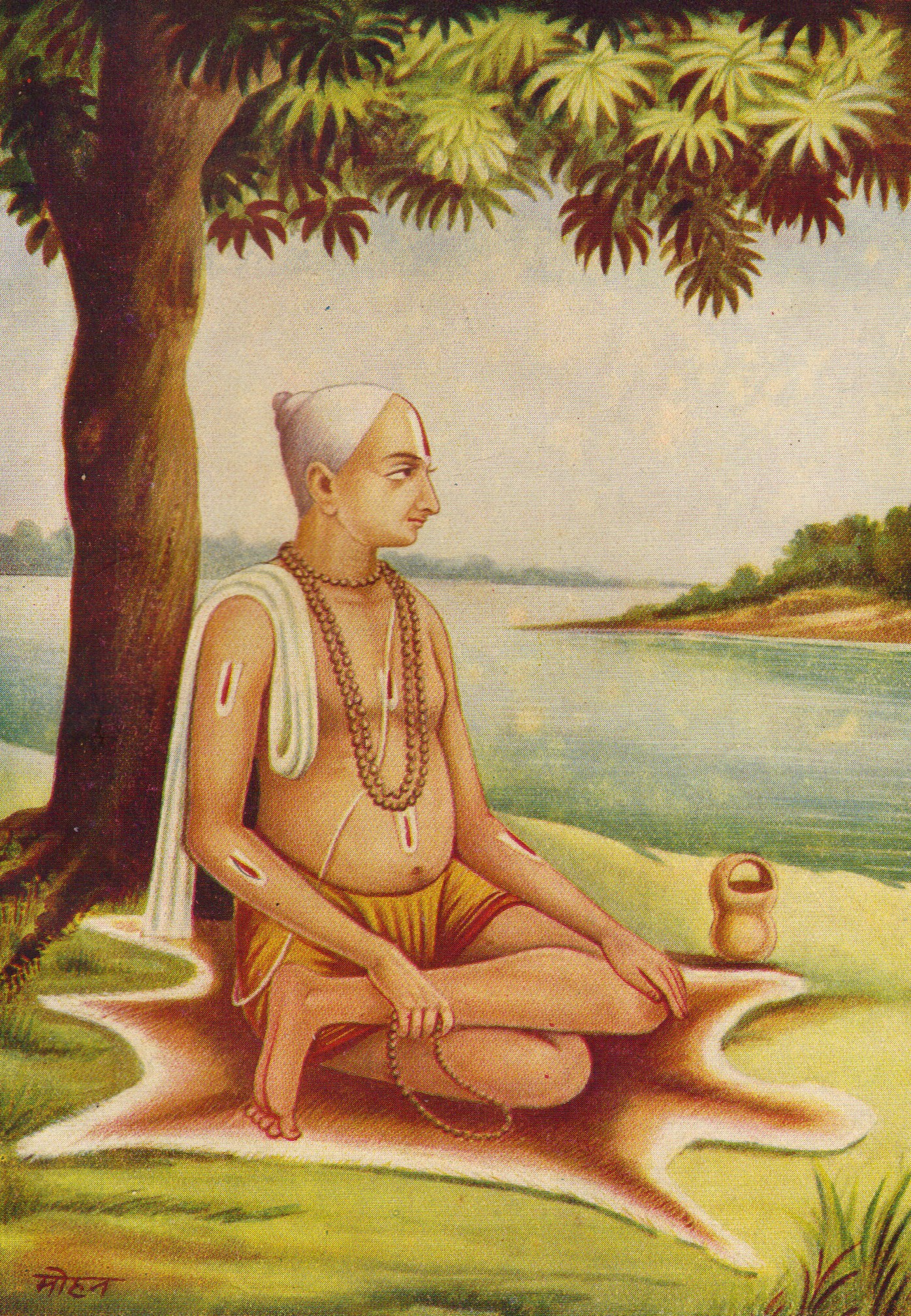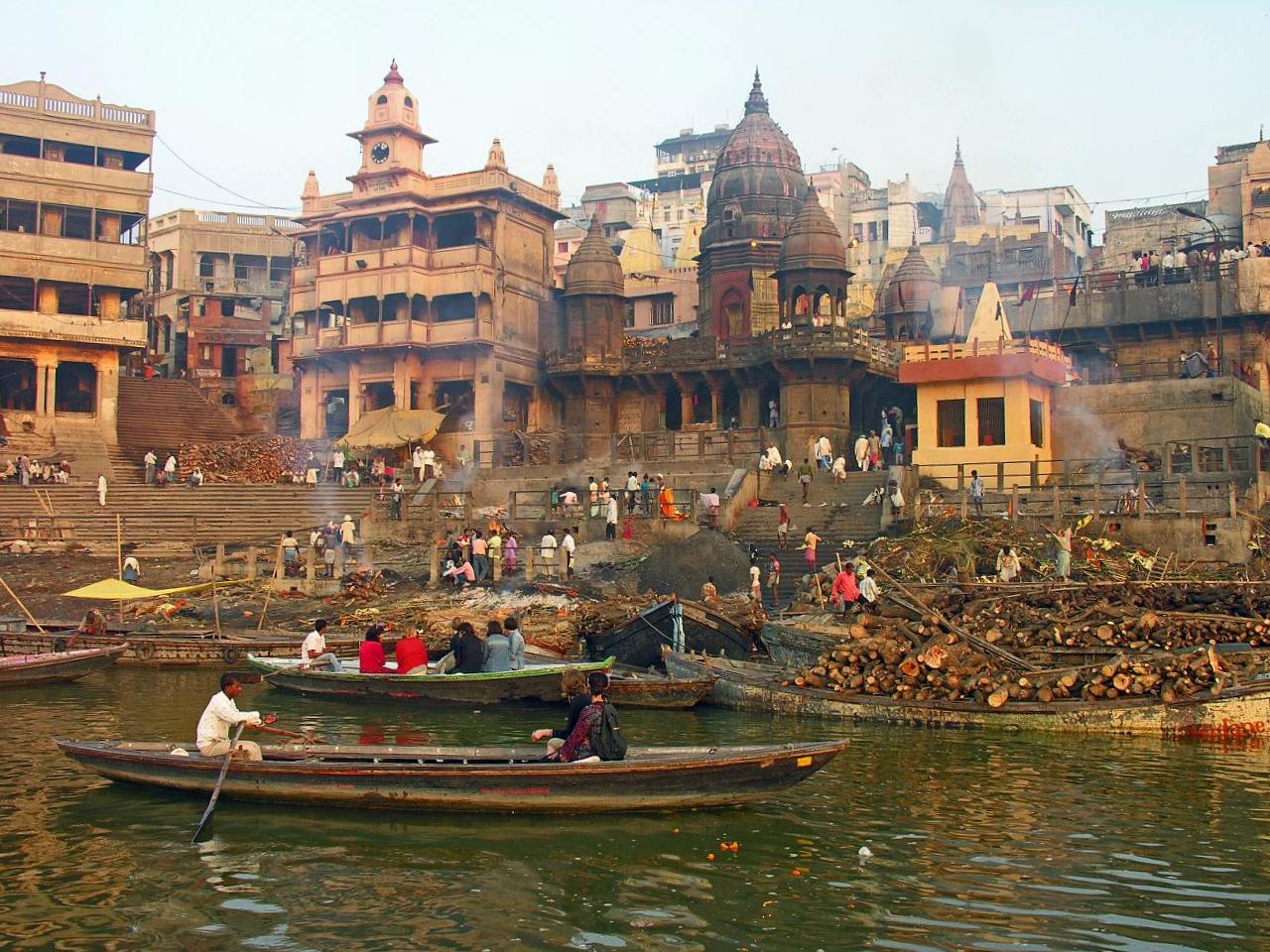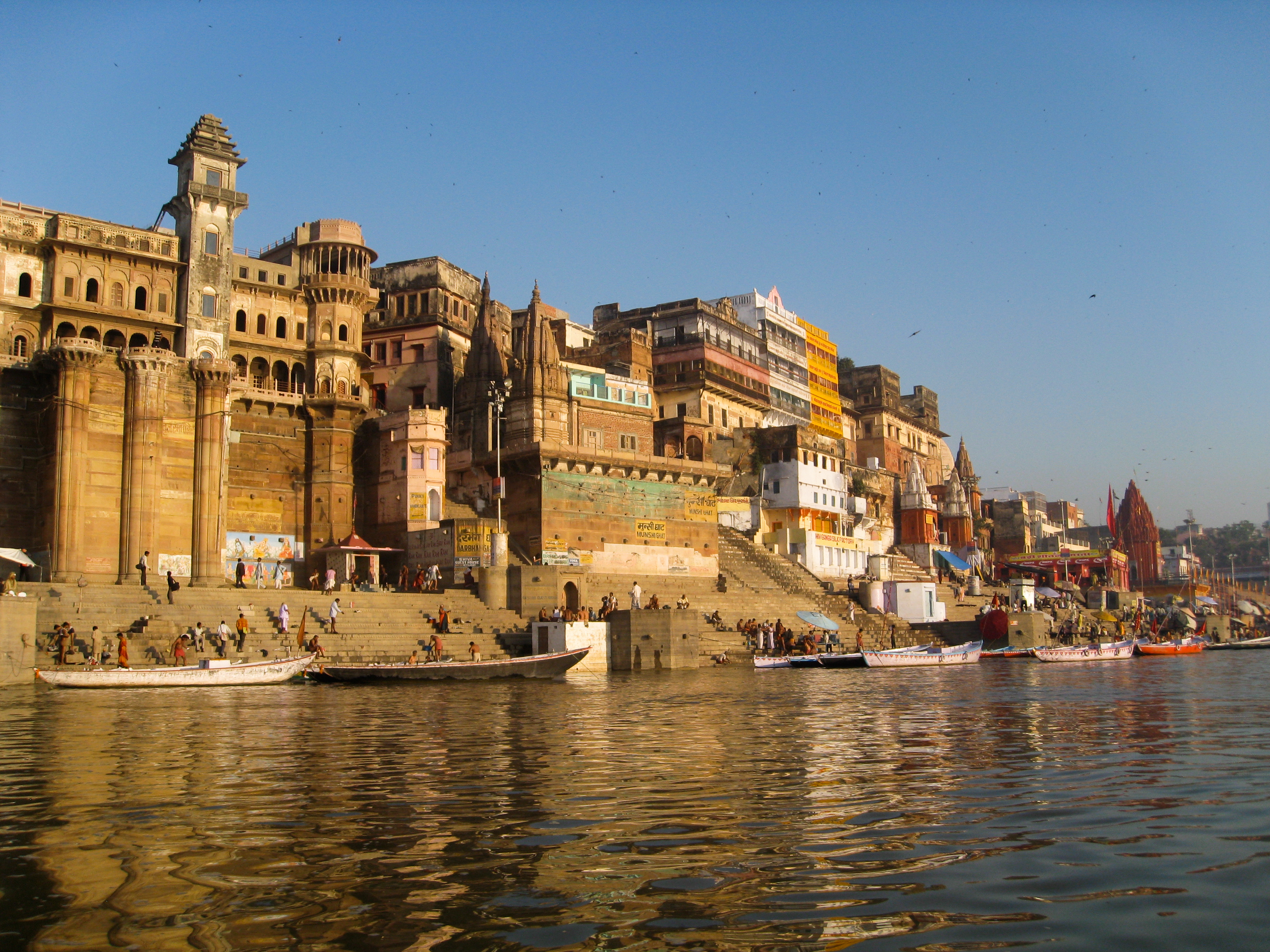|
Varanasi
Varanasi (; ; also Banaras or Benares (; ), and Kashi.) is a city on the Ganges river in northern India that has a central place in the traditions of pilgrimage, death, and mourning in the Hindu world. * * * * The city has a syncretic tradition of Muslim artisanship that underpins its religious tourism. * * * * * Located in the middle-Ganges valley in the southeastern part of the state of Uttar Pradesh, Varanasi lies on the left bank of the river. It is to the southeast of India's capital New Delhi and to the east of the state capital, Lucknow. It lies downstream of Allahabad (officially Prayagraj), where the confluence with the Yamuna river is another major Hindu pilgrimage site. Varanasi is one of the world's oldest continually inhabited cities. Kashi, its ancient name, was associated with a kingdom of the same name of 2,500 years ago. The Lion capital of Ashoka at nearby Sarnath has been interpreted to be a commemoration of the Buddha's first sermon there ... [...More Info...] [...Related Items...] OR: [Wikipedia] [Google] [Baidu] |
Benares Hindu University
Banaras Hindu University (BHU) IAST: kāśī hindū viśvavidyālaya International Phonetic Alphabet, IPA: /kaːʃiː hɪnd̪uː ʋɪʃwəʋid̪jaːləj/), is a Collegiate university, collegiate, Central university (India), central, and Research university, research university located in Varanasi, Uttar Pradesh, India, and founded in 1916. The university incorporated the Central Hindu College, founded by Indian Home Rule-leaguer and Theosophy, Theosophist, Annie Besant in 1898. After Besant and her associates were marginalized, the university was established by Madan Mohan Malaviya with the financial support of the maharaja of Dharbhanga Rameshwar Singh, the maharaja of Benares Prabhu Narayan Singh, and the lawyer Sunder Lal (lawyer), Sunder Lal. With over 30,000 students, and 18,000 residing on campus, BHU is the largest residential college, residential university in Asia. The university is one of the eight public institutions declared as an Institutes of Eminence, Institut ... [...More Info...] [...Related Items...] OR: [Wikipedia] [Google] [Baidu] |
Varanasi District
Varanasi district is a district in the north Indian state of Uttar Pradesh, with Varanasi city as the district headquarters. It is surrounded by Mirzapur district, Jaunpur district, Ghazipur district, Chandauli district, and Bhadohi district. The Ganga (Ganges) river flows through the district. Part of the Varanasi division, the district occupies an area of and Census of India, it had a population of 3,676,841. Divisions The district is made up of four tehsils: Varanasi, Pindra, Ramnagr, and Rajatalab, and eight Vidhan Sabha (Legislative Assembly) constituencies: Pindra, Shivpur, Rohaniya, Varanasi North, Varanasi South, Varanasi Cantt., Sevapuri, and Ajagara. Demographics According to the 2011 census, Varanasi district has a population of 3,676,841, This gives it a ranking of 75th in India (out of a total of 640). The district has a population density of . Its population growth rate over the decade 2001-2011 was 17.32%. Varanasi has a sex ratio of 909 female ... [...More Info...] [...Related Items...] OR: [Wikipedia] [Google] [Baidu] |
Goswami Tulsidas
Tulsidas (; born Rambola Dubey; also known as Goswami Tulsidas; c.1511pp. 23–34.–1623) was a Ramanandi Vaishnava Hindu saint and poet, renowned for his devotion to the deity Rama. He wrote several popular works in Sanskrit and Awadhi, but is best known as the author of the ''Hanuman Chalisa'' and of the epic '' '', a retelling of the Sanskrit ''Ramayana'' based on Rama's life in the vernacular Awadhi. Tulsidas spent most of his life in the city of Varanasi and Ayodhya. The Tulsi Ghat on the Ganges River in Varanasi is named after him. He founded the Sankatmochan Temple dedicated to Lord Hanuman in Varanasi, believed to stand at the place where he had the sight of the deity. Tulsidas started the Ramlila plays, a folk-theatre adaptation of the Ramayana.: ... this book ... is also a drama, because Goswami Tulasidasa started his ''Ram Lila'' on the basis of this book, which even now is performed in the same manner everywhere. He has been acclaimed as one of the greatest poe ... [...More Info...] [...Related Items...] OR: [Wikipedia] [Google] [Baidu] |
Ganges
The Ganges ( ) (in India: Ganga ( ); in Bangladesh: Padma ( )). "The Ganges Basin, known in India as the Ganga and in Bangladesh as the Padma, is an international river to which India, Bangladesh, Nepal and China are the riparian states." is a trans-boundary river of Asia which flows through India and Bangladesh. The river rises in the western Himalayas in the Indian state of Uttarakhand. It flows south and east through the Gangetic plain of North India, receiving the right-bank tributary, the Yamuna, which also rises in the western Indian Himalayas, and several left-bank tributaries from Nepal that account for the bulk of its flow. In West Bengal state, India, a feeder canal taking off from its right bank diverts 50% of its flow southwards, artificially connecting it to the Hooghly river. The Ganges continues into Bangladesh, its name changing to the Padma. It is then joined by the Jamuna, the lower stream of the Brahmaputra, and eventually the Meghna, forming the major ... [...More Info...] [...Related Items...] OR: [Wikipedia] [Google] [Baidu] |
Uttar Pradesh
Uttar Pradesh (; , 'Northern Province') is a state in northern India. With over 200 million inhabitants, it is the most populated state in India as well as the most populous country subdivision in the world. It was established in 1950 after India had become a republic. It was a successor to the United Provinces (UP) during the period of the Dominion of India (1947–1950), which in turn was a successor to the United Provinces (UP) established in 1935, and eventually of the United Provinces of Agra and Oudh established in 1902 during the British Raj. The state is divided into 18 divisions and 75 districts, with the state capital being Lucknow, and Prayagraj serving as the judicial capital. On 9 November 2000, a new state, Uttaranchal (now Uttarakhand), was created from Uttar Pradesh's western Himalayan hill region. The two major rivers of the state, the Ganges and its tributary Yamuna, meet at the Triveni Sangam in Prayagraj, a Hindu pilgrimage site. Ot ... [...More Info...] [...Related Items...] OR: [Wikipedia] [Google] [Baidu] |
Manikarnika Ghat
Manikarnika Ghat (Hindi: मणिकर्णिका घाट) is one of the holiest cremation grounds among the sacred riverfronts (ghats), alongside the river Ganges, in the city of Varanasi in the Indian state of Uttar Pradesh. In Hinduism, death is considered a gateway to another life marked by the result of one's karma. It is believed that a human's soul attains moksha, and hence breaks the cycle of rebirth when cremated here. Thus, scores of the elderly across the whole country seek to walk up to its edges, and spend their last days absorbing the charisma of the ghat making death painless and insignificant to be pondered upon. The ghat is named after Sati's earrings which fell here. The Hindu genealogy registers at Varanasi are kept here. Location The Manikarnika Ghat is flanked by the Dashashwamedh Ghat and the Scindia Ghat. It is situated in Varanasi, Kashi region, India. Mythological origin The Manikarnika Ghat is one of the oldest ghats in Varanasi. It is m ... [...More Info...] [...Related Items...] OR: [Wikipedia] [Google] [Baidu] |
Varanasi Division
Varanasi division is an administrative geographical unit of Uttar Pradesh state of India. Varanasi is the administrative headquarters of the division. Currently (2018), the division consists of districts of Varanasi, Chandauli, Ghazipur, and Jaunpur and is loosely equivalent to the Benares State. Districts * Varanasi * Chandauli * Ghazipur * Jaunpur History In the 18th Century the Mughal Empire was dissolving, and the eastern portion of present-day Uttar Pradesh State came under the control of Saadat Ali Khan I, the first Nawab of Awadh. In 1722, Saadat Ali Khan sublet his southern territories, comprising the present-day districts of Bhadohi, Chandauli, Jaunpur, Ghazipur, Mirzapur, Sonbhadra, and Varanasi, to zamindar Mir Rustam Ali. Mir Rustam Ali was deposed in 1738, and Mansa Ram became zamindar. On Mansa Ram's death in 1739, his son Balwant Singh succeeded him, and established himself raja of Benares State. Balwant Singh and added present-day Ghazipur and Ballia dist ... [...More Info...] [...Related Items...] OR: [Wikipedia] [Google] [Baidu] |
Varanasi Municipal Corporation
Varanasi Municipal Corporation is the governing body of the city of Varanasi in the Indian state of Uttar Pradesh. The municipal corporation consists of democratically elected members, is headed by a mayor, and administers the city's infrastructure and public services. Members from the state's leading various political parties hold elected offices in the corporation. History Varanasi has been a metropolitan municipality with a mayor-council form of government. Varanasi Municipal Corporation was established on 24 January 1959 as a Nagar Mahapalika under the Municipal Corporation Act of 1959 and in 1994 it was ungraded to Nagar Nigam. With 110 wards and currently the total area under it is around and Kunj Bihari Gupta as cities first Mayor and P.K. Kaul as a Municipal Commissioner. The Varanasi Municipal Corporation is responsible for public education, correctional institutions, libraries, public safety, recreational facilities, sanitation, water supply, local planning, and welf ... [...More Info...] [...Related Items...] OR: [Wikipedia] [Google] [Baidu] |
Mridula Jaiswal
Mridula Jaiswal is an Indian politician and the current mayor of Varanasi, Uttar Pradesh. Political life Jaiswal is a Bharatiya Janata Party politician. In 2017, she became the mayor of Varanasi, Uttar Pradesh. In the corporation election, she defeated Indian National Congress candidate Shalini Yadav by a margin of 78,843 votes. Residence She lives Near "Ghanti Mill Road", Sigra in Varanasi. References Living people Bharatiya Janata Party politicians from Uttar Pradesh Mayors of Varanasi Year of birth missing (living people) Women mayors of places in Uttar Pradesh {{India-mayor-stub ... [...More Info...] [...Related Items...] OR: [Wikipedia] [Google] [Baidu] |
Benares Sanskrit College
Sampurnanand Sanskrit Vishwavidyalaya (IAST: ; formerly Varanaseya Sanskrit Vishwavidyalaya and Government Sanskrit College, Varanasi) is an Indian university and institution of higher learning located in Varanasi, Uttar Pradesh, specializing in the study of Sanskrit and related fields. History In 1791, during the Benares State, a resident of the East India Company, Jonathan Duncan, proposed the establishment of a Sanskrit college for the development and preservation of Sanskrit ''Vangmaya'' (eloquence) to demonstrate British support for Indian education. The initiative was sanctioned by governor general lord Cornwallis. The first teacher of the institution was Pandit Kashinath and the governor general sanctioned a budget of 20,000 per annum. The first principal of Government Sanskrit College was John Muir, followed by James R. Ballantyne, Ralph T. H. Griffith, George Thibaut, Arthur Venis, Sir Ganganath Jha and Gopinath Kaviraj. In 1857, the college began postgraduate tea ... [...More Info...] [...Related Items...] OR: [Wikipedia] [Google] [Baidu] |
Munshi Ghat
Munshi Ghat is one of the Ghats in Varanasi, Uttar Pradesh, India. Significance Built in the year 1812, Munshi Ghat is named after Sridhara Narayana Munshi, who was a finance minister in the estate of Nagpur. In 1915, the Brahmin king Kameshwar Singh Gautam Bahadur of Darbhanga (Bihar) purchased the ghat and extended it. The extension later became known as Darbhanga Ghat. Darbhanga Ghat extension The palace of Darbhanga Ghat is made of sandstone from Chunar, with beautiful porches and Greek pillars. This area has been of importance in the Puranic Purana (; sa, , '; literally meaning "ancient, old"Merriam-Webster's Encyclopedia of Literature (1995 Edition), Article on Puranas, , page 915) is a vast genre of Indian literature about a wide range of topics, particularly about legends an ... context, but has also gained importance for its grandeur and architectural style. In 1994 the Darbhanga palace was purchased by the Clarks Hotel Group, who named it the Brijrama ... [...More Info...] [...Related Items...] OR: [Wikipedia] [Google] [Baidu] |
Ustad Bismillah Khan
Bismillah Khan (born Amaruddin Khan, 21 March 1916 – 21 August 2006), often referred to by the title ''Ustad'', was an Indian musician credited with popularizing the shehnai, a reeded woodwind instrument. While the shehnai had long held importance as a folk instrument played primarily schooled in traditional ceremonies, Khan is credited with elevating its status and bringing it to the concert stage. He was awarded India's highest civilian honour, the Bharat Ratna, in 2001, becoming the third classical musician of India after M. S. Subbalakshmi and Ravi Shankar to be awarded the Bharat Ratna. Personal life Bismillah Khan was born on 21 March 1916 into a family of traditional Muslim musicians at the town of Dumraon, British India, as the second son of Paigambar Bux Khan and Mitthanbai. His father was a court musician employed in the court of Maharaja Keshav Prasad Singh of Dumraon Estate in Bihar. His two grandfathers Ustad Salar Hussain Khan and Rasool Bux Khan were als ... [...More Info...] [...Related Items...] OR: [Wikipedia] [Google] [Baidu] |







